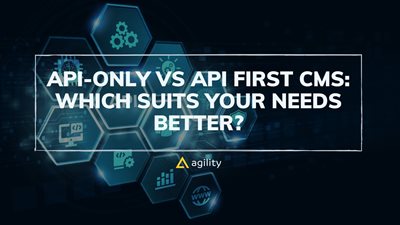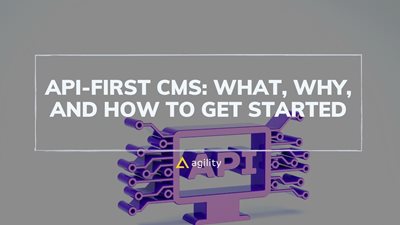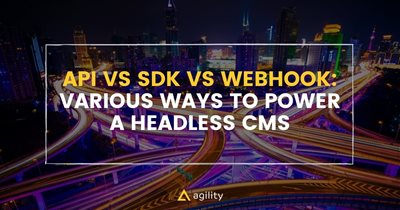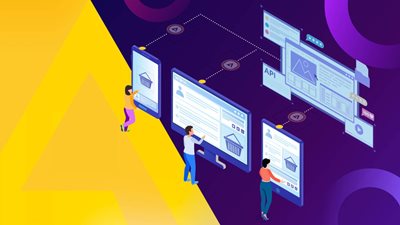API-only vs API First CMS: Which suits your needs better?
While some believe that API first CMS is synonymous with headless CMS, this is not the case. Discover why you need an API-first CMS & the differences.


While some may believe that API-first CMS is synonymous with headless CMS, this is not the case. It's not just about web content management when you're API-based or have API-based architecture. APIs are vital in today's software world because they allow programs to access data and connect with third-party services and systems.
An API-first CMS can help businesses use these third-party services and deliver content across many channels and consumer interfaces, laying the groundwork for a best-of-breed digital experience platform.
In this article:
- What is an API?
- How does an API work?
- What Is an API-first CMS?
- Why API-First CMS Beats All-In-One Suite Platforms
- Reasons Adopting an API-first CMS is Critical for Business
- Difference between an API-only vs. API-first approach
- The evolution of the CMS & the no-API approach
- API-only architecture
- API-first architecture
- Top advantages of internet marketing
- FAQs
What Is an API?

Application Programming Interface
API stands for an application programming interface. An API is a software middleman, often known as a go-between, allowing two apps to communicate. APIs are used every time you engage with someone on Facebook, buy something on Amazon, or read the news on your phone.
An API works like follows: when you use an app on your computer or phone, it connects to the internet and sends your data to a server. The server takes the data, interprets it as needed for the app, and then sends a response to the phone or computer that you can comprehend.
What Is API Testing?

APIs are tested to see if they fulfill functionality, security, performance, and dependability expectations. API functional testing is critical because APIs are the primary interface in application logic. Testers have discovered that GUI tests (graphic user interface tests) are challenging to maintain and provide limited coverage, especially given the frequent changes in DevOps and Agile software.
API testing has been found to increase the coverage of application tests considerably.
APIs are tested directly or in isolation by testers as part of end-to-end testing in integration testing.
Transactions contain a variety of endpoints outside of RESTful APIs, such as:
- Web UIs
- Mainframes
- ESBs
- Web services
- ERPs
Testers test a development team's APIs. They also test the team's APIs in the application and any third-party APIs. The tests establish whether the APIs produce relevant results in the correct format for a wide range of queries and whether the APIs react appropriately to unexpected or severe inputs and failures. SOAP web services or REST APIs with XML or JSON message loading are commonly tested, with the system communicating across JMS, HTTP, HTTPS, and MQ. Other message formats used by testers include EDI, FIX, and SWIFT.
Typical API automated testing involves the following:

- Unit testing
- Load testing
- Functional testing
- Security testing
- Detection of runtime errors
- Web UI testing
- Penetration testing
- Fuzz testing
What Is Application Security Testing?
In all phases of the software development process, application security testing (AST) entails utilizing multiple testing approaches to improve the quality and security of software applications by finding, remediating, and eventually preventing flaws and vulnerabilities.
This is a tried and true method of preventing cyberattacks. The most common type of external attack is application security assault. As a result, one of security decision-makers top goals and concerns is increasing application security.
How does an API work?
APIs function
We'll start with the REST API, the most popular today, to demonstrate how APIs function. Developers make a call or send a request to gain access to an API and send or receive data in this case. JSON is used to communicate with APIs, and there are four ways to transmit and receive data using REST APIs:

GET:
For example, GET information from a server- taking content from a database.
PUT:
Updates data in a resource that already exists. For instance, you may update a blog article or a web page.
POST:
Creates a new resource and sends data to a server. Create a new blog entry, for example.
DELETE:
Removes a resource from the system- delete a blog post or a web page.
These methods demonstrate how to use an API. However, using the example of a restaurant customer is the simplest method to explain how APIs function. A consumer places an order by informing the waiter of their desires. The waiter communicates this information to the kitchen, preparing the meal and creating the order before passing it on to the waiter, who then delivers it to the customer. The customer in this example is a user who makes a request, and the waiter is an API who passes that request to the kitchen or server. The API then delivers the response to the user when the server executes the request.
Let's look at how all of this relates to an API-first CMS.
What Is an API First CMS?

An API-first CMS, such as Agility CMS, decouples an application's front-end presentation layer from its back-end by enabling content distribution and interactions with other services through APIs. Marketers and developers may use this method to work more efficiently and manage information across several touchpoints.
Back-end content, files, and folders are strongly coupled with the front-end presentation layer in traditional CMSs like WordPress and Drupal. While these platforms can provide content to laptops, mobile devices, and tablets, they hinder business flexibility and scalability when satisfying content demands across many interfaces.
Enterprises can publish content to any channel with an API-first CMS, including the web, mobile, IoT-powered devices, AR/VR, smart vehicles, digital assets, etc.
Why API First CMS Beats All-In-One Suite Platforms

While suite solutions like Sitecore give an all-in-one set of services, an API-first CMS allows for easy interaction with best-of-breed services and provides the foundation on which to develop your IT ecosystem.
API-first CMSs are modular and composable. You can use an API to integrate or remove services as needed, rather than having everything in one massive, complicated platform with features that vary in performance.
With monolithic suites, there's always the risk that you're not getting the most out of some of the functionality. You don't have the freedom to connect best-of-breed services, limiting your ability to compete with your rivals. A MACH-aligned architecture built to satisfy current, and future expectations is an API-first CMS.
More training or engagement with external organizations or implementation partners is required for these monolithic suites. This is because it has a complex design and many features. On the other hand, marketers and developers can employ API-first CMSs to benefit from a flexible and user-friendly solution.
Reasons Adopting an API First CMS is Critical for Business
1. Increases the productivity and longevity of developers
Traditional content management systems grew in popularity when few development languages and an all-in-one solution compared to the problematic, DIY alternatives available. Today, however, that all-in-one solution acts as a set of handcuffs, preventing organizations from maximizing their content across many marketing and sales channels and internet-enabled gadgets.
You can only use one development platform with a typical CMS. This limits you to needing to discover and recruit a particular type of developer and just being able to make use of a slice of the ever-growing technical universe.
They should preferably be fluent in a single language. Even better, they should already be familiar with the ins and outs of your CMS. And more importantly, they're entirely comfortable with continuing to use that CMS to avoid disrupting the business processes you've developed around it.
What should a corporation do if several of these unicorns aren't found in the wild? Spend the resources and time necessary to recruit and train them for a very particular specialty that will hopefully not become obsolete anytime soon.
Replace your standard CMS with an API-first CMS to save time and resources while creating a development staff that enjoys their workflow.
Your development team can use what they know, what they love, and what they think will be the best answer in any case with an API-first CMS. In this situation, increasing productivity isn't the only way to save time and money—consider the longevity of developers with diverse abilities who are eager to put them to work for you.
2. Your Company Is Future-Proofed (and content)
It's natural for us to want to plan a project based on a static, "completed" condition we've imagined. Who among us hasn't made the mistake of naming something in our wireframes or content models something implementation-specific like "Christmas 2018 slider" or "top-right sidebar"?
On the other hand, technology tends to evolve in ways that go beyond our best-laid plans. Organizations need to use an API-first headless CMS to reconcile the two.
A headless CMS allows your businesses to separate content creation from planning how that material will be presented to end-users. This enables us to create content modules that are flexible enough to evolve independently of one another and withstand the test of time as your website inevitably requires updates; the number of display channels continues to expand; and the use of mobile devices such as watches, glasses, and smartphones has surpassed that of desktop computers.
Furthermore, if your content isn't tied to a particular CMS platform, you'll be able to change the technology on which it's stored as needed, further future-proofing your hard-won material by leveraging the best front-end for interaction.
3. Ensures a Pleasurable User Experience
Because it allows front-end developers to use the best technology for the job, an API-first CMS will enable them to create delightful user interfaces that are impossible to create with traditional, server-side CMS technology—all without limiting functionality or autonomy for content managers on the back-end.
In a world of increasingly connected and competitive digital marketplaces and eCommerce, these interactions add a lot of personality and character to your brand's online presence, which is becoming increasingly important as businesses strive to differentiate themselves on something other than branding, selection, or price.
4. Consistent Marketing in an Omnichannel Environment
The omnichannel era has arrived. For marketers, this means devising a strategy that provides customers with a consistent experience whether they're interacting with your brand on a desktop, mobile device, or at a physical store.
The majority of shoppers have been seen to shop on both physical and digital sites. And the more engaged they are in more areas, the more likely they are to spend more, stay loyal, and suggest others to your company. It's evident that omnichannel marketing is essential for businesses to remain competitive, and the best way to do it is with an API-first CMS.
API-first headless CMS platforms are designed to deliver content to various channels and devices using the best technology available for each endpoint. They're one of the first and most powerful technologies designed to support the omnichannel future of business.
One of the first things to suffer without such a powerful CMS is marketing consistency. Even tiny discrepancies in language and design from platform to platform might detract from the trustworthy, intelligent, and expert image you want to project to users. When your competition is just a click away, continuous multichannel marketing may be the only way to retain customers and leads interested in your company.
5. Improves Agility to Help You Get to Market More Quickly
For IT, marketing, and other business-critical groups that need to offer value to your market in record time, an API-first CMS provides a simplified, streamlined experience.
No CMS is as fast or straightforward as an API-first CMS when implementing and deploying modifications to your content management system. Because the CMS is distinct from any custom code, continuous deployment and other agile development approaches may be utilized to swiftly update and roll back changes without causing scheduled downtime or risking malfunctioning of the entire content management platform.
Difference between an API-only vs. API-first approach
CMSs did not incorporate APIs in their implementations a little over a decade ago. Back then, the back end of CMSs—where the content was created, maintained, and saved (as well as where design and customization took place)—was inextricably tied to the front-end frameworks, where the material was displayed the end-user. Both of them were housed in the same building. These no-API CMSs are still around today, but they're now referred to as linked CMSs.
No-API CMSs are popular among content teams because they are incredibly user-friendly. A no-API CMS has built-in themes and templates that allow content creators to customize the front end easily. As a result, organizations using a no-API CMS don't rely heavily on IT to set up and manage content, operate the CMS, or display content to end-users. As a technical leader, you don't have to devote much time to assisting in content delivery.
No-API CMSs are fantastic for smaller-scale projects like blogs, but you give up flexibility for simplicity and user-friendliness as people become more innovative and more Internet-capable; the end-users that businesses were seeking to reach embraced devices from all corners of the spectrum. Audiences were no longer only reading information while sitting in front of their computers; they also checked smartwatches for news updates in the mornings or asked Amazon Alexa to provide highlights. All of this occurred before they even sat down at their computer for the day. Organizations that do not reach out to their audiences in these ways will find that they are disengaged.
What is an API-first approach?
An API-first approach is a development methodology where developers prioritize the design and development of APIs before developing any user interfaces or backend services. In this approach, the API is treated as the core of the application, and all other components are built around it.
The API-first approach is different from the traditional approach, where developers focus on creating user interfaces and backend services first, and APIs are developed later to support these services. In an API-first approach, developers start by designing the API, creating a specification, and testing it. This ensures that the API is robust, flexible, and can accommodate future changes.
Why use an API-first approach?
An API-first approach offers several benefits over the traditional approach:
-
Better scalability: An API-first approach allows developers to build scalable applications that can easily accommodate changes and growth. APIs are designed to be flexible and can handle changes in data formats and systems, making them ideal for scaling applications.
-
Reduced development time: By focusing on APIs first, developers can reduce the time and resources required for development. APIs can be reused across different platforms and applications, reducing the need for redundant code and speeding up development time.
-
Improved collaboration: An API-first approach promotes collaboration between developers, designers, and stakeholders. By focusing on the API's design and functionality, everyone involved can have a better understanding of the application's goals and requirements.
-
Better user experience: An API-first approach can help developers create better user experiences by allowing them to focus on the functionality and data that is most important to the user. This approach enables developers to design interfaces that provide users with the information and functionality they need.
-
Increased security: APIs are designed with security in mind, making them a more secure way to exchange data between different systems. An API-first approach ensures that security is a top priority from the beginning of development.
API-only architecture

The so-called headless CMS was one of these new CMS breeds. The headless CMS, unlike no-API CMSs, takes an "API-only" approach.
Organizations that use an API-only CMS don't get the front-end code they need to create a comprehensive experience, whether it's a website, a mobile app, or anything else. They receive the API and, maybe, a back-end interface for data input.
One of the benefits of this strategy is that your company can choose the front end that best suits your needs, allowing you far more freedom than before. Not only that, but because your API-only CMS is built to connect to any front end via its API, you'll be covered as new intelligent devices emerge. There are other advantages to an API-only CMS over its non-API counterpart, such as:
- API-only CMSs are more secure because there is no direct access to the database from the front end.
- It is often faster to deploy changes.
- To assist the CMS integration into your IT stack, it usually comes with out-of-the-box integrations.
- You may save money because you don't have to update the back end every time you add a new channel.
There are, of course, exceptions.
If the no-API CMS enables content creators to manage and display the content quickly to their audiences without heavy IT relationship—an architecture that sacrifices flexibility for user-friendliness—the API-only CMS does the inverse: you'll have more flexibility, but you'll also need back end developers to handle the back end and front-end developers to handle content delivery to ensure content seamlessly reaches your audiences. This is because API-only CMSs split your codebase and responsibilities, necessitating the usage of separate back-end and front-end engineers.
API-first architecture
Thankfully, there is a happy medium between these two approaches in what is known as the API-first approach, also known as a decoupled CMS.
An API-first approach works similarly to an API-only CMS in that the API is always available to take data from the back end and present it to applications or other channels that end users will see. However, the API-first approach goes a step further by providing your organization with the tools, plugins, templates, and other rendering options it will need to build out a site. Despite acting independently, the back and front end are still linked because the front end is predefined with a specific delivery environment.
Companies that use their CMS to achieve an API-first strategy have all of the same flexibility as those who use an API-only approach:
- There is still a boundary between the front end and the database in an API-first approach, which increases security.
- It is easier to deploy modifications.
- The CMS comes with pre-built integrations to help it integrate into your tech stack.
- Reduces costs because you don't have to update the back end every time you add a new channel.
It's no longer a question of sacrificing usability or flexibility to engage your consumers as they consume content; with an API-first strategy, you get the best of both worlds. Content editors can produce and manage content while previewing it, ensuring that the final product is engaging and reaches your target viewers no matter where they are.
Top advantages of internet marketing
- You have a worldwide reach and are not limited to a single region.
This is one of the most beneficial aspects of web marketing. You can reach your target demographic by marketing your business beyond your local location. Without needing to travel, online marketing allows you to connect with people worldwide.
- Attract targeted internet consumers, are multitasking capable, and offer a continuity effect.
Unlike traditional marketing tactics, web marketing assists you in attracting clients who require your products. Most importantly, you do not need to be present to do marketing; all you need is a well-organized website.
- Improved brand engagement through round-the-clock brand optimization
A company's most important marketing tool is an efficient online presence. This can help you stand out in a crowded market and grow while maintaining positive brand awareness.
- Online marketing is both cost and time-efficient.
To ultimately develop a digital marketing plan, you only need a small amount of money. You can start with blog promotion, social media marketing on the internet, or email marketing. In comparison to typical advertising methods, these three channels need less investment.
- Everything in web marketing can be measured and automated.
Everything may be followed and tracked using elaborate diagrams in online marketing. The graphs show how certain search marketing activities affected activity development, traffic increase, leads, and deal transformations. You may also use tools like Google Analytics to track the success of your internet marketing activities.
- Ensures speedy and convenient service delivery by providing real-time targeted results.
You can use digital tools to precisely target specific customer demographics. With a solid web marketing approach, you'll have to wait weeks to see a visible increase in your business.
- Follow-up is simple and helps marketers retain a customer relationship after the sale.
Consumers replace business cards and look for them when they require a service or product in traditional marketing. You may quickly obtain the email addresses of both the customer and the prospects via digital marketing. This allows you to maintain a robust after-sales relationship with your current clients.
FAQs on the API First CMS Approach
What Is React?
React is a UI development library based on JavaScript. Facebook and an open-source developer community run it. Although React is more of a library than a language, it is frequently utilized in web development.
What is SaaS?
Software as a service (SaaS) is a method of delivering software through the internet. Instead of installing and maintaining software, you use the internet to access it, eliminating the need for complicated software and device maintenance.
Web-based software, on-demand software, and hosted software are used to describe SaaS applications. SaaS apps, whatever their name, are hosted on the servers of a SaaS provider. The service provider is in charge of the application's security, availability, and performance.
What Is WYSIWYG Exactly?
WYSIWYG is an abbreviation for "what you see is what you get." The term refers to software's ability to show users exactly how each content type will look without additional work or coding. The idea behind WYSIWYG is that any changes made on the screen are automatically reflected in the final output, eliminating the need for any additional steps.
What Is A webhook?
A webhook (also known as a web callback or HTTP push API) is a method for an app to provide real-time information to other apps. A webhook sends data to other applications as it happens, so you get it right away, unlike traditional APIs, which require you to poll for data frequently to get it in real-time. Webhooks become much more efficient as a result for both provider and consumer. The only disadvantage of webhooks is the difficulty in setting them up at first.
What Is GraphQL?
GraphQL is a query language and server-side runtime for application programming interfaces (APIs) that prioritizes providing clients with only the information they need.
GraphQL is intended to make APIs more responsive, flexible, and developer-friendly. It can even be used within the GraphiQL integrated development environment (IDE). GraphQL, a REST alternative, allows developers to create requests that pull data from multiple data sources in a single API call.
What is Vue.js?
Vue.js allows you to extend HTML with HTML attributes known as directives. HTML applications can benefit from the functionality provided by Vue.js directives.
What is a headless CMS?
Any back-end content management system in which the content repository "body" is separated or decoupled from the presentation layer "head" is referred to as a headless content management system. A headless CMS's Content is delivered via APIs for seamless display across multiple devices.
Traditional CMS platforms may include a "headless API" that allows you to send content to a separate presentation layer. Because the presentation layer is separated from the body, this is referred to as "headless."
Top API First CMS Vendors
- Agility- Agility is a cloud-based API-first CMS that provides a headless CMS solution for managing content across different platforms
-
Contentful - Contentful is a cloud-based API-first CMS that allows developers to manage and deliver content across different channels and devices using APIs.
-
Strapi - Strapi is an open-source API-first CMS that provides a flexible and scalable solution for managing content across different platforms.
-
Kentico Kontent - Kentico Kontent is a cloud-based API-first CMS that provides a headless CMS solution for managing and delivering content across different channels and devices.
Agility's API First CMS
Agility's API-first CMS is a part of their Content Platform, which enables a best-of-breed architecture for their clients. With an API-first approach, clients can choose the best tools and services for their specific needs and requirements and integrate them seamlessly with Agility's CMS to deliver content across different channels and devices.
Agility's Content Platform provides a headless CMS solution that separates content from presentation and allows developers to access and manipulate content via APIs. This enables clients to create, manage, and deliver content across different platforms and devices, including websites, mobile apps, digital signage, and more.
With Agility's API-first CMS, clients can take advantage of the flexibility and scalability of headless content management while still benefiting from the powerful features and functionalities of a traditional CMS. They can use Agility's built-in content modeling tools to create and structure content and then use APIs to deliver that content to different channels and devices.
Agility's API-first CMS supports a wide range of APIs, including RESTful APIs, GraphQL APIs, and webhooks, which enables clients to integrate with different tools and services. They can choose the best tools for their specific needs, such as e-commerce platforms, marketing automation tools, or analytics platforms, and then use APIs to connect those tools seamlessly with Agility's CMS.
By enabling a best-of-breed architecture, Agility's API-first CMS empowers clients to deliver personalized and engaging experiences to their customers across different channels and devices. They can leverage different tools and services' strengths while maintaining control and consistency over their content. This approach also allows for easier updates and changes, as clients can make changes to their content without having to update their entire technology stack.

About the Author
Jonathan Aisiki is a Senior Writer at MarketingForCustomers.com. He writes B2B articles and creates SaaS marketing content that deliver visible results. His goal is to educate and offer as much unique value as possible to readers.
View Related Resources

API-first CMS: What, Why, and How to Get Started

API vs SDK vs Webhooks Explained: Various Ways to Power a Headless CMS

